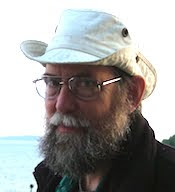I wrote this essay [for my now-discontinued column in the S&W Report] at the Westboro Medical Clinic in the Loblaws Superstore, on Richmond Road, in Ottawa, as we waited for physicians to be available to renew prescriptions as we set out on the Maritime leg of our 30-years-later expedition. The last time we were there (45.393N 75.749W), on the 2nd of March 2010, we were delighted to see a Dryocopus pileatus (Pileated Woodpecker) steadily working halfway up a big streetside Ash tree, high above passing Dogs and pedestrians. It had given a trumpet-like flicker call when it flew in, and then was silent until it left, half an hour later.
These Crow-sized Woodpeckers used to be a shy species of the deep woods, but they're not surprising anywhere anymore, as hundreds of cellphone photos attest. One feature of eastern Ontario is that the trees in settlements are larger than those in the countryside, because urban lawn trees were valued as amenities, and urban woodlot trees were neglected, in the decades when the rural trees were only valued as fuel and lumber. This means that there's plenty of habitat for Pileateds in the city, once they'd gotten over their fear of being shot by anyone who noticed them.
The vernacular English name for Dryocopus pileatus was “Logcock,” which reflected the 18th and 19th Century practice of shooting and eating them at every opportunity. I've never tasted Dryocopus, but during my graduate student days as a bird collector, I did sample the related and also ant-eating Flicker (Colaptes), and can affirm that there was plenty of culinary motive for shooting at Woodpeckers – and Dryocopus was the only species that would provide a meal for an entire family.
One of the theories about why surviving Ivory-bill Woodpeckers, the other big North American Woodpecker species, are so hard to discover is that they're descended from those that were excessively wary of People, and preserve an inherited skittishness. The same selection for wariness would have applied to Pileateds in the decades when they were culinary trophies.
Among big Birds and Mammals, wariness is a combination of culture and genetic heritage, and over the past 30 years it seems to me that it has noticeably decreased in many species, though of course it's very hard to find any quantitative evidence to test this idea, or to disentangle the genetic and cultural components of the supposed change. We first woke up to this on our 1994 survey of the Toronto Waterfront, when Woodchucks, in a camp in a fenced parkinglot in an industrial harbour where they'd never been offered handouts, were, to our rural minds, recklessly bold.
This set us to thinking about our observation, on our honeymoon trip to British Columbia in 1973, that west coast Great Blue Herons were strikingly less wary than their Ontario relatives. We attributed this to the BC birds having been shot at for only a fraction of the time (1860-1940?) that the Ontario populations had been subject to (1780-1960?). But by 1994, and even more strikingly now, Ontario Herons are as bold as the western birds used to be: in a recent visit to the Lynde Shores estuary in Whitby the Herons got out of our way very reluctantly, and below the Oxford Mills Dam on Kemptville Creek they even seem sulky when an artist displaces them from their fishing spot on the shallow bedrock flats below the dam.
Once People stop shooting at big Birds, those that aren't skittish save energy by not fleeing every time they see a Person. As the conservation lesson has been learned by the human population, there are not only increased populations of big Birds, but also much better opportunities to see them. Ravens fly over the Westboro Medical Clinic, Turkeys peck at the very verge of Highway 416, Turkey Vultures rock along over the highways looking for the slain, local broods of Canada Geese loiter in the Ottawa River between the Champlain Bridge Islands under the hovering wings of Ospreys – and these are just the big birds I've seen in the past few days which wouldn't have been here thirty years ago. Even the Ring-bill Gulls that cruise the Ottawa River were brought back by the protection of the Migratory Bird Convention – the egg & feather trades had made Gulls rare in late 19th Century North America
Of course, there are other contributing causes in many of these cases: cessation of DDT and nesting platforms for the Ospreys, dumps and by-catch for the Gulls, roadkill for the Vultures, and intentional releases of the Turkeys and Geese – but in each case the Birds today seem far less wary than they were in the past, and it's hard not to think that both culturally-transmitted learning and selection for genes for boldness have contributed to the increased populations.
Not shooting at a spectacular Bird when it's illegal to do so is a relatively easy lesson to learn: the observer himself would prefer not to be shot, so it's easy to infer that the Bird is similarly appreciative (though it's important to remember what a boost to status bringing back an unusual or edible trophy used to be).
Overall biodiversity and ecosystem integrity are larger problems that require more complex understanding from the human population, but perhaps not an impossible level of understanding. [When I wrote this] we were just back from Whitby where we found that the streams to be perplexingly barren, but with banks thronged by alien plants, and we were stunned by the extent to which the Pink Jewelweed, Impatiens glandulifera, Jerusalem Artichoke (Helianthus tuberosus), Bishops- or Gout-weed (Aegopodium podagraria), the amazing Dog-strangling Vine, Vincetoxicum, and Colts-foot (Tussalago farfara) have taken over the valleys of streams that drain into Lake Ontario. ...but that's another story.
